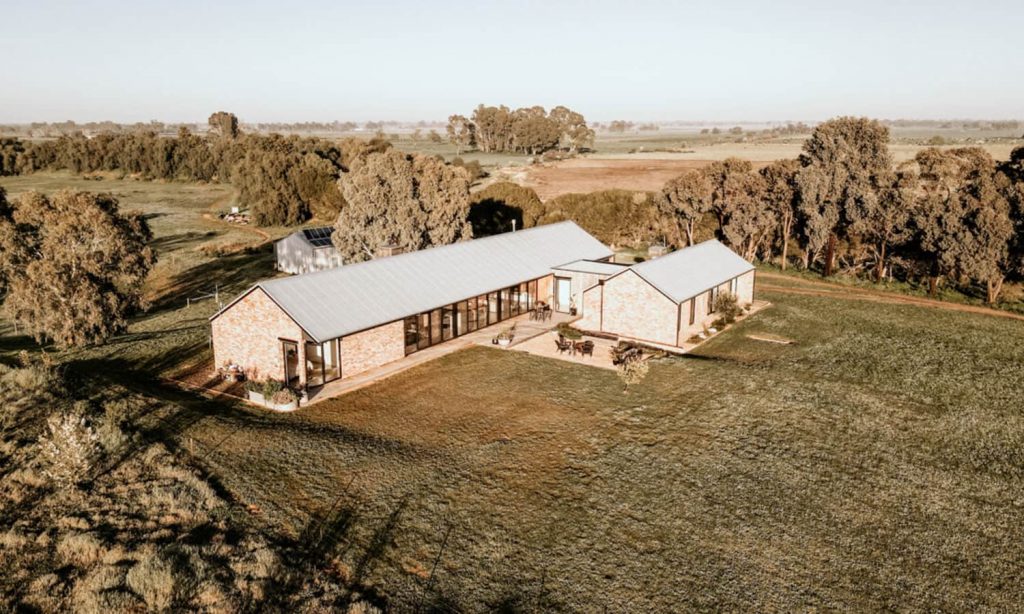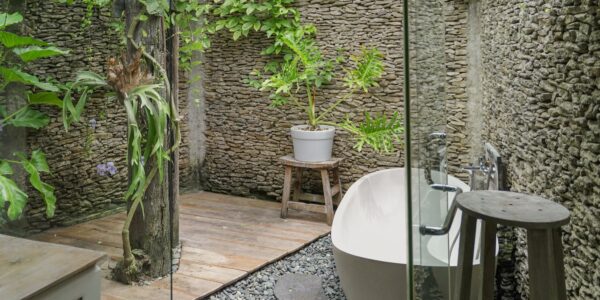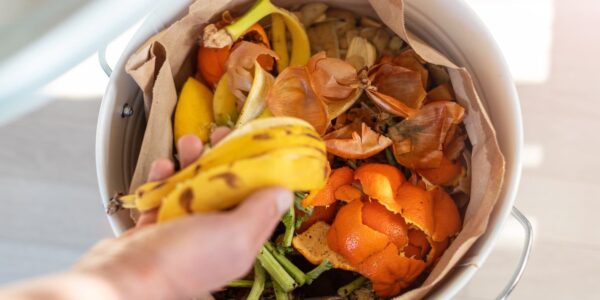A sustainable renovation is key to reducing your home’s environmental impact, though has the added benefit of saving you money in both and short and long term.
Below, with the help of Lisa Booth, founder of Booken Blend and a passionate climate advocate who recently built her own off-grid home, and Simon Clark, director of Sustainable Homes Melbourne, we break down nine sustainable renovating terms and show you why you need to consider these in your next home update.
1. Passive design
Passive design takes into account a property’s environmental position and its relation to the elements, and through cleverly thought-out plans, is constructed to make the most of sunlight, shade and ventilation.
When done well, passive design renders the need for external heating and cooling, and this in turn can reduce around 40% of a home’s energy costs. A designer or architect may suggest fixtures like skylights, double-glazed windows, insulation, open air-ways and extra sealing to achieve this.
“Designing a renovation to make use of nature’s free resources — such as the sun and cooling breezes, is the first step towards creating a home that is light-filled, energy-efficient and comfortable all year round,” says Booth.
“The key to getting this right is understanding orientation. We start every project by orientating as many rooms as possible to the north, we then add double glazing and appropriate shading to this north face to capatalise on the natural pathway of the sun. Once we have the orientation correct, we focus on adding other essential passive design principles such as thermal mass, cross ventilation, minimising east and west windows, and insulating.”
2. Green roofs
“Otherwise known as rooftop gardens, green roofs create greener spaces in our urban world, while simultaneously providing some of the best roof insulation available,” says Clark.
Whether a sparse native garden, beehive or grass roof, any greenery on this underutilized space is better than nothing, plus, a green roof does well to regulate temperature and insulate your abode.
3. Buying reclaimed/recycled materials
One sure-fire way to add instant character and life to a renovated or new home is by utilising recycled materials. Whether bricks, floorboards, fluted glass, or front doors, reusing materials is both a sustainable alternative to buying new and will save you money to spend in other areas.
“Reclaiming material from a rundown old home and restoring it to include within the renovation is always a talking point and is without doubt a feel-good moment for any renovator,” says Clark.
Booth agrees, adding: “Step off the consumerist treadmill for a moment and into a more resourceful and eco-friendly space. Even better, many of the reclaimed products we have used come with their own unique story, which adds depth and history to a new build or reno.”
Similarly, you should look to recycle waste produced by your own demolition. You may have decided you’ve no use for your old materials, but by responsibly recycling these, you can help reduce the 8.5 million tonnes of building waste that ends up in landfill each year in Australia.
4. Native gardens
Not only are native gardens great for attracting native birds, bees and wildlife to your home, but they’re likely to use a significantly less amount of water. Australian native plants are conditioned to our often harsh and dry environment and thus require less watering.
“Working with species that are drought tolerant and naturally adapted to thrive in our immediate environment is a great way to make you appear a much better gardener,” jokes Booth, adding the native plants have a second, more sentimental value to your home.
“Using species of plants that are indigenous to our area has been a lovely way to contribute to the regeneration of this land we now call home. These plants help create a sense of place and connection to the history of our property.”
5. Solar energy and rainwater tanks
By nailing the passive design elements of your home, you will significantly reduce the energy requirements of your home, Booth says. “This then makes it far more affordable and achievable to supplement your remaining power usage with technology such as solar.”
Booth’s latest build, Beaver House at The Sandhill, is self-sufficient for both power and water. “A solar array collects power directly from the sun and excess energy is stored in a battery bank for use after the sun goes down or on cloudy days. We also have a large rainwater tank which collects water from both the roof of the house and the shed, which meets the needs of our family of six.”
Clark says solar panels have come down in price more recently, and are likely to pay themselves off after around two years of use. Similarly, he says rainwater tanks are in high demand, particularly for people who “can’t stand the thought that our drinking water is being used on lawns and gardens”.
6. Natural light and LED lighting
“If you get the orientation and passive design of your home correct then natural light will flood your home, minimising the need for artificial lighting,” says Booth.
To ensure natural lighting in your home, you may need to look into expanding your window sizes, adding skylights and floorplans to enhance the orientation, which may cost more at first, however, these investments will pay themselves off when artificial lighting is no longer needed during the day.
When lighting is required, opt for LED bulbs. “LEDs have changed the game and made lighting a home incredibly economical,” says Clarke.
7. Eco-friendly paints
Clarke notes the importance of eco-friendly paints for sustainable renovations today. Eco-friendly paints create less emissions and less odour, plus they’re better for you — the person who has to deal with the smell.
“Generally speaking, all paints these days are low in VOCs (Volatile Organic Compounds), however there are options of zero VOC paints,” he says.
“It’s likely to be a growing issue for those aware of the impact of VOCs particularly with the advent of working from home and the uptick in home improvement.”
8. Water-saving tapware and appliances
“The more efficient an appliance, the less waste is created and the less money it will cost to run,” says Clarke. “All taps must have a high WELS (Water Efficiency Labelling Scheme) rating, it’s particularly important in bathrooms and showers where water can be mindlessly wasted.”
When choosing tapware, opt for those with high WELS ratings, though ensure that when your reno is complete, you don’t forget to conserve water according to best practice. Stick to four-minute showers, run the dishwasher only when it’s full, and turn off the tap in between use.
9. Second-hand furniture
Your efforts for a sustainable build will be dulled the moment you choose to furnish your home with entirely new pieces.
“When we moved into our brand new eco-friendly home, I promised myself I would not run out and buy all new furniture to fill it, because put simply, furnishing our house with new ‘stuff’ would counter all the reasons we chose to build sustainably in the first place,” says Booth.
“This pushed me to be more resourceful and thoughtful about the things I included in our home, and Gumtree got a real work out for a while!”
Clarke also makes a strong case for the character and charm second-hand decor can bring to a newly renovated space. “We’re seeing more and more people appreciate the uniqueness of old furniture that was often handcrafted. When creating a sustainable and architecturally designed home it makes sense to decorate it with the same values in mind.”







